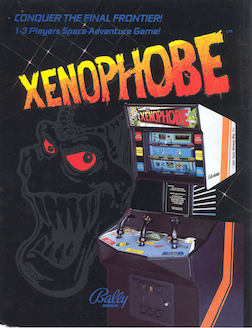
Xenophobe is a video game developed by Bally Midway and released in arcades in 1987. Starbases, moons, ships, and space cities are infested with aliens, and the players have to kill the aliens before each is completely overrun. The screen is split into three horizontally-scrolling windows, one for each of up to three players, yet all players are in the same game world.

Joust is an action game developed by Williams Electronics and released in arcades in 1982. While not the first two-player cooperative video game, Joust's success and polished implementation popularized the concept. Players assume the role of knights armed with lances and mounted on large birds, who must fly around the screen and defeat enemy knights riding buzzards.

Defender is a horizontally scrolling shooter developed by Williams Electronics in 1980 and released as an arcade video game in 1981. The game is set on either an unnamed planet or city where the player must defeat waves of invading aliens while protecting astronauts. Development was led by Eugene Jarvis, a pinball programmer at Williams; Defender was Jarvis's first video game project and drew inspiration from Space Invaders and Asteroids. Defender was demonstrated in late 1980, before entering production in early 1981. It was distributed in Japan by Taito.
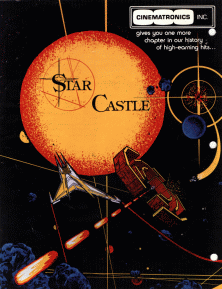
Star Castle is a vector graphics multidirectional shooter released in arcades by Cinematronics in 1980. The game involves obliterating a series of defenses orbiting a stationary turret in the center of the screen. The display is black and white with the colors of the rings and screen provided by a transparent plastic screen overlay.

Tempest is a 1981 arcade video game by Atari, Inc., designed and programmed by Dave Theurer. It takes place on a three-dimensional surface divided into lanes, sometimes as a closed tube, and viewed from one end. The player controls a claw-shaped "blaster" that sits on the edge of the surface, snapping from segment to segment as a rotary knob is turned, and can fire blaster shots to destroy enemies and obstacles by pressing a button.

Robotron: 2084 is a multidirectional shooter developed by Eugene Jarvis and Larry DeMar of Vid Kidz and released in arcades by Williams Electronics in 1982. The game is set in the year 2084 in a fictional world where robots have turned against humans in a cybernetic revolt. The aim is to defeat endless waves of robots, rescue surviving humans, and earn as many points as possible.

Star Wars is a first-person rail shooter designed by Mike Hally and released as an arcade video game in 1983 by Atari, Inc. It uses 3D color vector graphics to simulate the assault on the Death Star from the 1977 film Star Wars. There are three connected gameplay sequences: combat against TIE fighters in space, flying across the surface of the Death Star, and the final trench run. The sequence repeats with added complications and the Death Star regenerating for each. The player's X-Wing fighter has a shield which only protects against damage a certain number of times, then the next hit ends the game. Speech synthesis emulates actors from the film.

Mine Storm is a multidirectional shooter similar to Atari, Inc.'s 1979 Asteroids arcade game. Designed and programmed by John Hall, it was published in 1982 by General Consumer Electronics as the built-in game for the Vectrex system. Although not provided on a physical cartridge, a Mine Storm screen overlay and manual were included with each system to support the built-in game.

Liberator is an arcade game released by Atari, Inc. in 1982. It is based on the Atari Force comic book series published by DC Comics from 1982 to 1986. Liberator has been described as the opposite of Missile Command, in that the player destroys cities from space instead of defending them from the ground. Only 762 arcade machines were ever made.
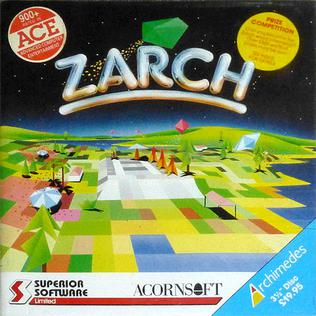
Zarch is a computer game developed by David Braben in 1987, for the release of the Acorn Archimedes computer. Zarch started off as a demo called Lander which was bundled with almost all releases of the Acorn Archimedes.
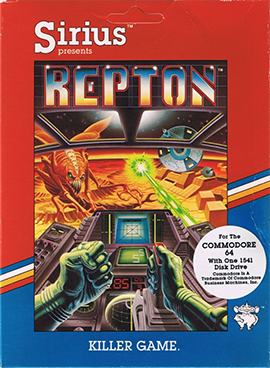
Repton is a Defender-inspired scrolling shooter written by Dan Thompson and Andy Kaluzniacki for the Apple II and published by Sirius Software in 1983. It was ported to the Atari 8-bit computers, and Commodore 64.

Crossfire is a multidirectional shooter created by Jay Sullivan for the Apple II and published by On-Line Systems in 1981. Using keyboard-based twin-stick shooter controls, the player maneuvers a ship in a grid-like maze. Versions with joystick-control use the stick for movement and switch to firing mode when the button is held down.

B-Wings is a vertically scrolling shooter first released as an arcade video game by Data East in 1984. A version was released in 1986 for the Family Computer. It was Data East's very first home release for the console.
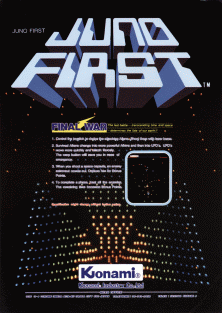
Juno First (ジュノファースト) is an arcade video game developed by Konami and released in 1983. It was licensed to Gottlieb in the United States. Juno First is a fixed shooter with a slightly tilted perspective, similar to Nintendo's Radar Scope from 1980. The game was ported to the Commodore 64, Atari 8-bit computers, MSX, IBM PC, and IBM PCjr.

Strike Force is a horizontally scrolling shooter released as an arcade video game by Midway in 1991. In the same way that 1990's Smash TV is a modernized reimagining of Robotron: 2084 with two-player simultaneous play, Strike Force is a modernized reimagining of Defender with two-player simultaneous play. Strike Force was not widely distributed and was not ported to any home systems.
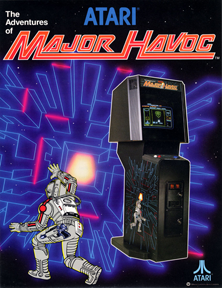
Major Havoc is an arcade action game released by Atari, Inc. in 1984. A vector-based upright arcade cabinet, Major Havoc consists of several smaller game experiences played in succession, including a fixed shooter, platform game, and a lunar lander sequence. It was developed by Owen Rubin with some levels designed and tuned by Mark Cerny, who joined the development team approximately a year into the game's development.

Starship 1 is a first-person shooter space combat game developed and manufactured for arcades in 1977 by Atari, Inc. The game, which takes great inspiration from the then very popular television series Star Trek, contains the first known Easter egg in any arcade game. The arcade game was distributed in Japan by Namco in 1978, and it was ported to the Atari 2600 as Star Ship.

Skull & Crossbones is a pirate-themed beat 'em up developed by Atari Games and released as an arcade video game in 1989. Developer Tengen ported the game to the Amiga, Amstrad CPC, Atari ST, Commodore 64, MS-DOS, Nintendo Entertainment System, and ZX Spectrum.

Space Zap is a space-themed fixed shooter arcade video game developed by Game-A-Tron and licensed to Midway Manufacturing in 1980. The player controls the defenses of an immobile base in the center of the screen which is attacked from the top, bottom, left, and right. Pressing one of four oversized buttons moves the gun in the corresponding direction. A fifth button fires. Space Zap shipped in three form factors: standard upright, cocktail, and Bally's Mini-Myte reduced size cabinet.

Threshold is a space-themed fixed shooter written by Warren Schwader and Ken Williams for the Apple II and published by On-Line Systems in 1981. Inspired by Sega's Astro Blaster arcade video game, Threshold introduces many enemy ship types and wave formations as the game progresses. Reviewers found the variety distinguished the game from the many similar shoot 'em ups.



















